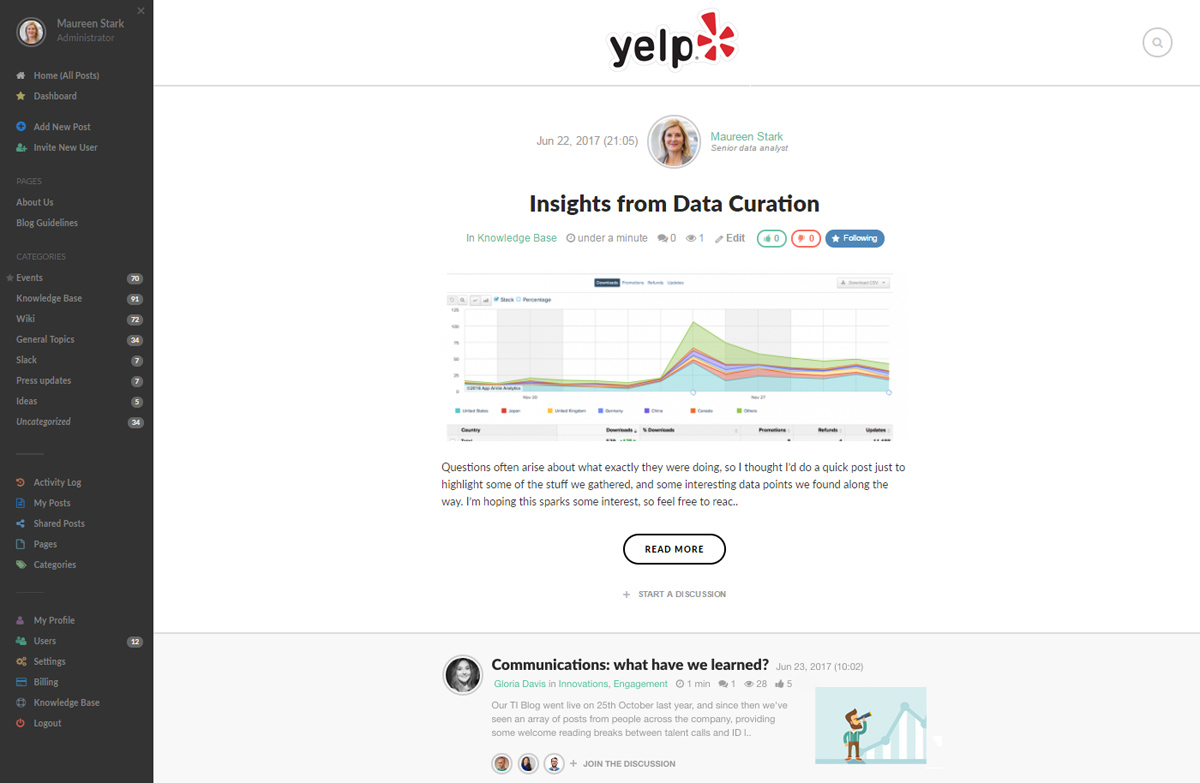Empowering your employees to proactively foster a meaningful work culture will take time and effort. One way to enable your team is through the enhancement of your internal communication practices.

Strengthening your internal communications process can lead to numerous benefits for your organization. Developing a culture where employees can talk about their wins, announcements, and interests can break department barriers and help build a better rapport between coworkers.
In this article, we’ll focus on helping you maximize your internal company blog for employee engagement. Keep reading to learn more about fully utilizing your company’s internal communications platform.
Why Use an Internal Company Blog?
In a study conducted by the University of Bielsko-Biala in Poland, it was found that having a repository of information readily available for team members was an effective communication tool. Having easy access to resources helped employees streamline their work and promoted knowledge sharing in the organization.
An internal company blog can help make a more cohesive team by allowing team members to know more about one another. While social media platforms can be a great way to share communications between employees, some individuals may choose to keep those websites strictly for personal use.
Using an internal blog for your internal comms can be the solution you need to promote collaboration and better working relationships.
Uses for Your Internal Company Blog
With the rise of companies with hybrid and work-from-home setups, it’s normal to find that there’s a lack of camaraderie between your employees. While team meetings and town hall assemblies can help staff get to know each other, it may still not be enough to establish an open communication channel.
Having an internal company blog can help you foster better working relationships, encourage information sharing, and update your stakeholders with company news. You can also allow team members to have their own digital space in the company to give them a sense of belonging, which can make them more likely to stay in your organization.

Here are some ideas to help you maximize your internal company blog:
Employee Spotlight
Having a category to spotlight your employees’ extracurricular achievements can help start conversations about interests with other team members. You can introduce new hires by sharing a short “About Me” post, giving teammates a space to share their hobbies, and spotlighting the exciting experiences of employees here.
For example, if you have an employee who recently completed a marathon, you can encourage them to post about their training regimen and their motivations.
Work Wins
Blog about new clients that your account managers have landed, share the shining reviews that clients gave about your services, and talk about the growth of your departments in this space.
Inform your employees about the wins that other team members have and give top-performing employees the recognition they deserve. Give departments that have reached their important goals a platform to discuss their challenges and how they overcame them.
Not only does having a category for work wins give credit where it is due, but it can also help others understand how to achieve the same results.
HR Corner
Giving your Human Resource team a space to talk about employee benefits, company policies, institutional values, and tax education can help improve the synergy around the organization. Having this vital information on an easy-to-access site will give them the answers they need immediately and without hassle.
If your engagements team scheduled any events or activities that are open to the company, you could announce them in your internal blog.
Company Milestones
Celebrating your company’s founding anniversary, reaching a growth target, and donating a percentage of profits to a charity the business believes in are just some of the articles you can post here.
Keeping your employees in the loop and showing them where their efforts are going can give them clarity about their role in the organization. Talking about your company’s contribution to society won’t just show that you practice your company’s values, but it will also allow your team members to see that their work has a positive impact on the world.

Best Practices
Tutorials or tips on the best practices that your employees do can be published here. Creating a best practices knowledge base will help your entire team cultivate information sharing and work smarter.
You can use this category to house employee workflow improvement tips, personal development courses, and technical skills classes that can help further their careers.
IT FAQs
Difficulty in navigating software, connectivity issues, and hardware problems are just some of the technical difficulties people regularly experience. Having an IT Help Desk for simple troubleshooting tutorials can help team members solve problems on their own and escalate only when complications aren’t going away.
Job Openings
Any new job opportunities that your company might have can be shared here. It’ll give your employees a chance to be aware of any new positions that they can apply to or refer qualified friends and acquaintances to the job.
Housekeeping Rules for Your Company Blog
Setting ground rules about the dos and don’ts of the blog can help with ease in moderation. At the end of the day, this blog is still a company space, and the goal is to foster a better company culture through these pages.
While the goal of the blog is to facilitate discussions and start conversations, some comments may not fulfill this goal. So, make sure to keep the blog a positive space to encourage others to contribute.
Fostering a Better Company Culture
Internal company blogs are a great digital tool where people can relax and be themselves. Using this communication tool can help create a collaborative and open communications workplace. Acknowledging the impact of internal communication among employees and showcasing their achievements will provide them with the sense of belonging and recognition that they deserve.
Final thoughts: 8-steps to make it work
-
Encourage participation: Encourage employees to contribute to the blog by sharing their ideas, experiences, and insights. This can create a sense of community and ownership among employees.
-
Make it accessible: Ensure that the blog is easily accessible to all employees, and that it is easy to navigate and use. This will encourage more employees to engage with the blog.
-
Keep it relevant: Make sure that the content on the blog is relevant and useful to employees. This can include information on company updates, industry news, and employee recognition.
-
Encourage dialogue: Allow employees to comment on blog posts and engage in discussions. This can help to foster a sense of community and encourage employees to share their thoughts and ideas.
-
Mix it up: Mix things up by including different types of content, such as videos, photos, and infographics. This can help to keep the blog interesting and engaging for employees.
-
Make it visible: Promote the blog internally through company newsletters, email, and internal social media platforms to ensure that all employees are aware of it and can access it.
-
Measure and evaluate: Regularly evaluate the engagement and participation of employees on the blog, use analytics tools to measure the success of the blog and adapt it accordingly to maximize engagement.
-
Lead by example: Encourage the leadership team to contribute to the blog and set an example for other employees to follow.
By implementing these strategies, companies can maximize the internal company blog as a tool for employee engagement and make it a valuable tool for internal communication and knowledge sharing.
